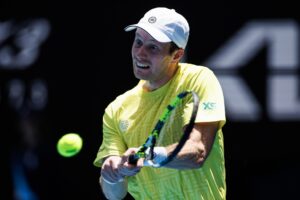At the start of this month, Jack Sock’s chances of making it to the end-of-season finale of men’s tennis, the ATP Finals, were remote. The World #22 didn’t even know he could still qualify. And yet, one heady week in Paris later, the Nebraska native found himself inside that coveted top eight (at least, among those still healthy) in the Race to London.
Such a sudden jump, the strength of the field in Paris (Sock did not meet a single higher-ranked player), and leapfrogging tennis’ deified underdog Juan Martin del Potro, inevitably led to a fair bit of cynicism – spurious claims that the 25-year-old had simply got lucky, and did not deserve to play in the elite competition.
Undeniably, he was lucky. Five of the top 10 at the end of last year are injured, and Federer missed Paris while Nadal was hampered by the knee trouble that has now ended his season. But the assertion that Sock was somehow not good enough for London – while, I daresay, perhaps validated by the meagre four points he won on Federer’s serve on Sunday – has surely now been put to bed following a fine 5-7 6-2 7-6(4) victory over world #5 Marin Cilic.
In spite of the vast gulf in big match experience between the two–Cilic a US Open champion and Wimbledon finalist–the American looked far more at ease throughout. True, the Croat’s somewhat frenzied way of bouncing the ball, and his intense narrowed-eye gaze across the net at his opponent doesn’t exactly exude happy-go-luckiness, but aside from a few flashes of rage, Sock looked like he was simply really enjoying his tennis.
He constantly mixed play up–one minute the consummate American baseliner, unleashing hammer-blow forehands and knifing slices deep into Cilic’s brittle backhand corner, the next showing the guile of a seasoned grass-courter with disguised drop shots and delicate topspin lobs. He was even a downright showman, attempting audacious one-handed backhanded angles and blasting hop forehand winners. After a sensational net cord pick up at 4-3 down in the third set tiebreak, sliding with the supple vigour of a peak Novak Djokovic to push a backhand past Cilic into the corner, he pumped his fist and raised his arms, urging the crowd to roar louder. With its glitz, glamour, and unrelenting indulgence in the dramatic (listen out for the heartbeat sound effects), the Finals turn tennis into theatre, and the world was Sock’s stage.
More notable, though, was the performance of Sock’s backhand wing. As frustrated American tennis fans well know, it is a shot with serious technical deficiencies – inexplicably lacking in racket-head speed, and without the arcing topspin to counterpunch with any kind of potency or accuracy.
From the first game, Cilic–wily tactician as ever–relentlessly pinned Sock into his backhand corner. Yet the American kept digging himself out, pushing his opponent’s high press back with the slice and rushing the Croat into high-octane baseline exchanges. Sock, in the past often frustratingly passive on that backhand side, ultimately dictated the match on his terms.
And let’s not forget that the impetuous 25-year-old looked down and out twice in this match – after Cilic’s demoralising first set smash-and-grab, and at a break down 3-0 at the start of the third. Far from the round-shoulders despondency American tennis fans have grown accustomed to seeing over the years, at each setback Sock fired himself up more, shouted a little louder, clenched his fist a little harder.
Sock has underachieved so far in his career. In spite of having broken into the top 30 in August 2015, he is yet to excel at the highest level–the fourth round at the US Open last year is his best Slam showing. He is a mercurial talent through and through – an extraordinary shot-maker, but with an extraordinary ability to self-destruct. All this is not about to change, but there are promising signs that Sock is beginning to step up on the big occasions.
“I think he’s probably one of the least good London qualifiers we’ve had in recent memory,” said Eurosport’s Katherine Whittaker on “The Tennis Podcast.” Sock’s qualification, she went on, indicates a degradation of quality at the top of the sport. “Given the dialogue on the game over the last few years has been the elevation of the level at the top to the extent that you cannot afford to have a weakness…” she posited. “As much as he does have great weapons he does have an enormous glaring weakness [his backhand]… and he’s not the fittest guy on tour either. The bar has lowered.”
On Tuesday’s evidence, where Sock had the crowd in his palm and every shot at his fingertips, it is clear that this is absolutely not the case. Time to cast aside the snobby contempt for a big forehand big serve game style. An American is back in the Finals for the first time in six years, and he could be about to stick around.
LastWordOnTennis would like to thank O2 Sports, the sponsor of the O2 arena, for giving us the tremendous opportunity to attend several sessions of the ATP Finals.
Main Photo:
Embed from Getty Images






